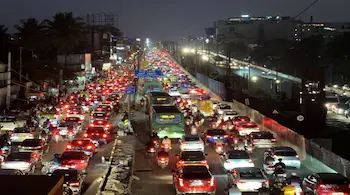Prerana Toshniwal, Pune
Data provided by Bengaluru’s Joint Commissioner of Police (Traffic) M N Anucheth revealed that the city’s newly introduced Adaptive Traffic Control System (BATCS) has significantly impacted traffic movement, resulting in a maximum reduction of 33% in travel times at crucial intersections throughout the city.
The AI-driven platform, introduced in May 2024, currently includes 60 intersections and is part of a larger initiative to update traffic control in the city known for its traffic.
The BATCS uses real-time data collection and AI analytics to dynamically adjust traffic signal timings according to current traffic volumes. The adaptive system, unlike traditional fixed-time traffic control systems, adjusts to traffic changes at every intersection. Anucheth stated that it has decreased avoidable delays and improved traffic flow, especially during peak hours.
Since being partially implemented, the BATCS has already shown substantial outcomes. Travel time has decreased by 20% on important routes like K R Road and Jayanagar, with the most notable improvement being a 33% reduction at Hudson Circle.
Moreover, the improved effectiveness has resulted in a greater hourly traffic flow, enabling smoother and more consistent movement as compared to the older manual traffic control system.
The real-time adaptability of the BATCS system sets it apart. The traffic signal timings at the 60 intersections are changed in real time depending on the number of vehicles tracked by camera sensors at every intersection entrance. This live data allows the system to generate a traffic flow that is more precise and effective.
Signals are coordinated along main roads, creating “green waves” that enable cars to travel without interruption for longer distances, decreasing the number of stops and enhancing commute times. Anucheth clarified that over 90 percent of signal adjustments are done automatically through AI, reducing the need for manual intervention in the system.
The control room in Bengaluru enables the Traffic Police to oversee the functioning of every signal, promptly making modifications if needed. Anucheth stated that emergency vehicles receive advantages from the system, allowing ambulances and fire trucks to be prioritized and travel through the city’s streets with minimal interruptions.
Bengaluru traffic police stated that the 60 junctions that have been upgraded so far are only part of the initial stage of the BATCS project, which aims to include a total of 165 junctions by January 2025. After that, the system will be enlarged to include 400 more intersections throughout the city.
The goal of Bengaluru Traffic Police is to establish the BATCS as a solution that benefits the entire city by boosting traffic efficiency, enhancing safety, and providing more dependable travel for all drivers.
The Bengaluru Traffic Police, along with Bruhat Bengaluru Mahanagara Palike (BBMP), have also made sure that the system will work well with other infrastructure projects, like road widening, flyovers, and tunnels.
